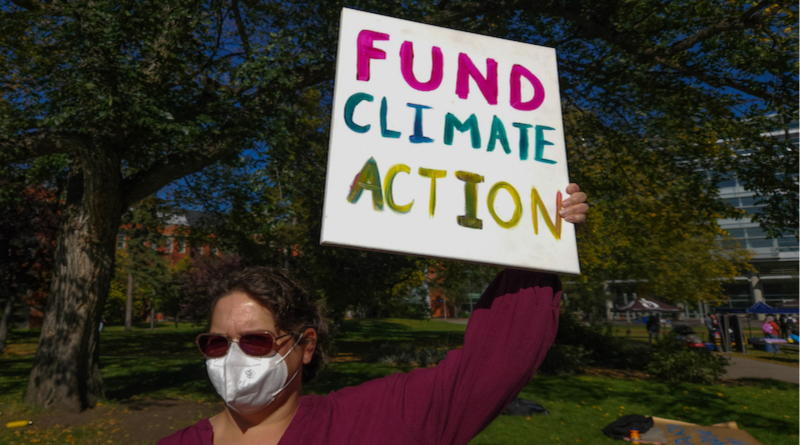Switzerland and Canada propose ways to expand climate finance donors

An activists holds a placard during a climate strike in September 2023, in Edmonton, Canada. Photo: Artur Widak/NurPhoto
As diplomats get ready to restart talks next month over the new UN climate finance target, the question of who should be putting money into the pot looms large over the negotiations.
Most developing countries offer a straightforward answer: keep the status quo, meaning only the countries classified as industrialised when the UN climate treaty was adopted in 1992.
But this club of developed nations, vocally led by the European Union and the United States, argues that the world has changed dramatically over the past three decades.
They now want other countries that have become wealthier – and more polluting – to pitch in for the post-2025 New Collective Quantified Goal (NCQG), set to be agreed at the COP29 climate summit in Baku this November.
China targeted
The EU wrote this week, in a document submitted as part of the NCQG negotiations, that “the collective goal can only be reached if parties with high [greenhouse gas]-emissions and economic capabilities join the effort”.
The US echoed that position in its latest submission, arguing that “those with the capacity to support others” in pursuing action to cut emissions and boost climate resilience “must also be accountable” for delivering on the climate finance target.
But, as governments polish their arguments ahead of the next round of talks in mid-September, climate finance experts warn of an uphill battle to get everyone to agree to a fair and accurate way to broaden the donor base.
For instance, as the world’s top polluter and the second-largest economy, China is the primary target of the finger-pointing. But, when the country’s emissions and wealth are divided by its enormous population, China does not rank among the main candidates for an expanded contributors’ pool, according to climate finance studies.
At annual climate talks in the German city of Bonn in June, China’s negotiator reacted angrily at suggestions his country should become a donor. “We have no intention to make your number look good or be part of your responsibility as we are doing all we can to save the world,” he said.
Who pays?
Switzerland and Canada have been the first nations to propose precise criteria to expand the list of contributors beyond developed countries.
The Swiss negotiators pitched two detailed metrics in their latest submission early this month.
The first would target the ten largest current emitters of carbon dioxide that also have a gross national income (GNI) per capita – adjusted for purchasing power parity – of more than $22,000.
Under this measure, Saudi Arabia and Russia would be included. China would too if it is calculated based on current international dollars, which Climate Home understands would be the Swiss intention, even though the proposal does not specify.
But China would be excluded if GNI per capita were based on constant 2021 international dollars, highlighting the ambiguity of the proposals at this point.
Populous nations with large absolute emissions like India, Indonesia, Brazil and Iran would be left out because the average wealth of their residents falls below the threshold, according to World Bank data.
Similarly, Canada’s proposal – released last Friday after this article was first published – singles out the top ten emitters but with a slightly lower GNI per capita threshold of $20,000. In this case, China would be included whichever GNI calculation is used.
The second category in the Swiss proposal targets countries that have cumulative past and current CO2 emissions per capita of at least 250 tonnes and a purchasing power parity-adjusted gross national income per capita of more than $40,000.
Assuming the Swiss proposal means emissions starting in 1990, then fossil fuel-producers in the Gulf like Qatar, the United Arab Emirates and Bahrain would be included, alongside South Korea, Singapore, Israel, Czechia and Poland.
Experts’ scepticism
But climate finance experts told Climate Home they are sceptical such strict criteria will work at the negotiating table and make it into a final decision.
“Discussing thresholds and indicators is a technical and politically charged issue, and it will be very difficult to get everyone to agree on them,” Laetitia Pettinotti, a research fellow at ODI, told Climate Home. She added that countries need to be encouraged to consider whether their emissions and GNI per capita are similar to those of developed countries, while also taking into account their climate vulnerability.
Pieter Pauw, assistant professor at the Eindhoven University of Technology, said the current system is “outdated and increasingly dysfunctional”, but the focus should be on making it less rigid rather than finding “arbitrary” ways to add more countries to a list.
Pauw is the co-author of a new study looking at options to increase the number of climate finance providers.
New “net recipients” category
The paper found that several developing countries, including China, Saudi Arabia and Russia, have shown appetite to finance multilateral development funds, such as the Global Fund to Fight AIDS, Tuberculosis and Malaria, but not those dedicated to climate action.
“It’s because the climate discourse is so politicised now,” Pauw said. “They are afraid that agreeing to contribute to a climate finance goal would set a precedent and burden them with more responsibilities.”
“It is important to find a way to have them join the ‘contributors club’ without putting a stamp on them and saying ‘OK, now you’re on the same level as developed countries’,” he added.
The study suggests one way out of the deadlock: instead of labelling countries rigidly as pure providers or recipients of climate aid, a third category of “net recipients” could be created. These would be nations that make financial contributions of any amount, while also being able to receive money at the same time.
“This compromise would allow countries to maintain their ‘developing’ status that gives them a right to receive finance where it is needed,” said Pauw. “But it also incentivises them to play a more proactive role that better reflects their new capabilities and responsibilities.”
Better transparency
A separate study by UK think-tank ODI suggests that many developing countries are voluntarily providing climate aid to fellow developing states, but their contributions go unrecognised at the moment because of a lack of transparency.
For example, China contributed over $10 billion in climate finance through its contributions to multilateral development banks and funds between 2015 and 2022, according to a newly updated ODI analysis shared with Climate Home and due to be released in early September.
Pettinotti thinks that the donor base could be expanded by recognising these contributions and bringing them to the surface through a better reporting system.
“There is not going to be coercion – that is just not going to work,” she told Climate Home. “Making space for a bottom-up, self-determined position is all we can do to encourage more countries to contribute.”
Developing-world opposition
Many developing countries have opposed any official discussion over an expansion of the donor base in the talks so far, claiming that is not part of the NCQG working group’s mandate. They have also complained that, while fixating on this issue, developed countries have failed to put forward proposals on other key elements of the NCQG, such as the size of the funding target.
Avantika Goswami, climate lead at the Delhi-based Centre for Science and Environment, told Climate Home that developed countries have “a moral imperative” to provide climate finance because of their historically high emissions over the past century.
“The contributor-base expansion debate cannot be resolved within the narrow timeline of November 2024 when the NCQG is due to be decided”, she added. “Pushing for this expansion as a bargaining chip will only derail constructive discussions.”





